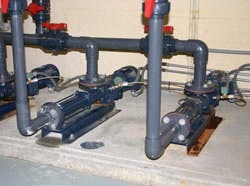Central Ohio's Del-Co Water Company has been treating (clarifying and softening) hard well and surface water for customers in Delaware and Morrow counties for nearly 40 years.
Del-Co, whose motto is "Quality on Tap," uses the same treatment techniques for all four of its plants to achieve water quality consistency.
The process is as follows:
- Raw water flows to single-stage solids contact basins for clarification and softening. The raw water hardness can vary from 180 mg/l in surface water, to 350 mg/l in ground water;
- Lime then softens water to 105 mg/l;
- Settled solids are transferred for further processing;
- Carbon dioxide is added to lower the pH, ending the softening process and stabilizing the water. This process takes approximately 4 hours;
- Water passes through sand filters to further remove small particulates;
- Finally, chlorine disinfects water prior to consumer use.
Problems addressed
Plant superintendent Damon Dye and maintenance supervisor Chuck Penry experienced several problems with the air operated diaphragm pumps, which were being used at two stages. The first was moving sludge from clarifying tanks in the basement to holding tanks for further settling. The second stage was removing settled sludge from the bottom of the holding tanks as needed. This usually happened daily. The problem was that the pumps were not responsive to the varying slurry densities and flow rates. Air valves and check valves often fouled and failed, resulting in frequent down time. In addition, the pumps were so noisy when operating that personnel complained they couldn’t hear each other talk.
Dye, Penry and their team consulted with a local fluids handling firm, where they learned about seepex progressive cavity (pc) pumps. Seepex then recommended its range "BN" (block) pumps to handle the abrasive lime slurry being pumped from the tanks.
A progressive cavity pump's single helix rotor rotates within an elastomeric double helix stator to form sealed cavities that progress from the suction side to the discharge end of the pump. The continuous seal between the rotor and the stator helixes moves the fluid steadily, without valves or pulsations. The fixed flow rate is proportional to the rotational speed of the pump, and is not affected by pressure fluctuations that can result from varying densities and viscosities of the fluid.
Del-Co has been using the pumps for over six years and the company has seen positive results. Not only do the pumps handle fluctuating flows with ease, but they also are able to pump the slurry directly through 6-inch piping for a full mile from tank to destination
Lonnie Evans, assistant maintenance supervisor, noted that pump maintenance only takes minutes when necessary.
Progressive cavity pumps are less complicated, have fewer parts, and are more energy efficient than air operated diaphragm pumps. Eliminating check valves and air valves alone results in a less complicated and problematic piece of equipment.
The trouble with air
In general, using air as an energy transmission medium is an inefficient and costly decision. Converting electrical energy to mechanical energy to air, and then back to mechanical energy is an inherently wasteful action. Moreover, powering equipment with compressed air requires additional equipment and maintenance. Chillers or desiccants are required to dry the air, while oil must be added to lubricate the compressor. The oil is subsequently removed to prevent corrosion or fouling of control or regulating valves.
The piping system for the air also needs constant maintenance and repair to prevent or stop costly leaks.
It is always a good idea to avoid air power when installing equipment for permanent use. Instead, opt for dedicated electric motors and switchgear. Capital and installation costs may be higher, but the energy and maintenance savings are so great that a permanent electric installation usually has a payback of a few months when compared with compressed air.
The Del-Co story
In 1969, concerned community members Timothy McNamara, Ralph Scott, and Gerald Solt anticipated the need for a dependable supply of quality water for current residents, as well as for the expanding population. Though extreme hardness does not make water unsafe to consume, they were worried that it wasn’t healthy for pipes, household plumbing, appliances, and cleaning processes. Hard water scale reduces energy efficiency, and requires extra cleaning products that could contribute to ground water contamination. The founding team wanted its customers to enjoy the economical, environmental, and health benefits that would result from water made safe for both drinking and general usage. This level of service was not typically provided to rural consumers.
McNamara, Scott and Solt took their concerns to the community, and eventually recruited a group of likeminded, visionary citizens. A company was formed, and a consulting engineer was hired. Farmers Home Administration gave the company low interest loans. The resulting first treatment plant could treat one mgd, with 200 miles of distribution piping, and served approximately 2,000 customers.
Currently, Del-Co Water Co., Inc. operates four water treatment plants with a current total capacity of 21 mgd, while serving nearly 39,000 customers. Surface waters are the source for three of the plants, obtained from Olentangy River and the Alum Creek Reservoir. The fourth plant takes its water from wells. The watershed for the area's water supply is part of the Upper Scioto Watershed, which is refilled with an average of 38 inches of rainfall annually. Snowmelt also contributes to the supply.
Del-Co Water is the largest rural water system in the state of Ohio. The operation continues as a community effort to provide high quality water as a private, nonprofit corporation owned by the water consumers. Del-Co is also a zero-discharge facility.
Annually, a local farmer hauls the lime sludge away and sells it to other local farmers for land application. The company is also still growing. Recently, Del-Co Water began construction on a new $30 million plant with a capacity to treat 19 mgd, scheduled to open in the summer of 2006.


